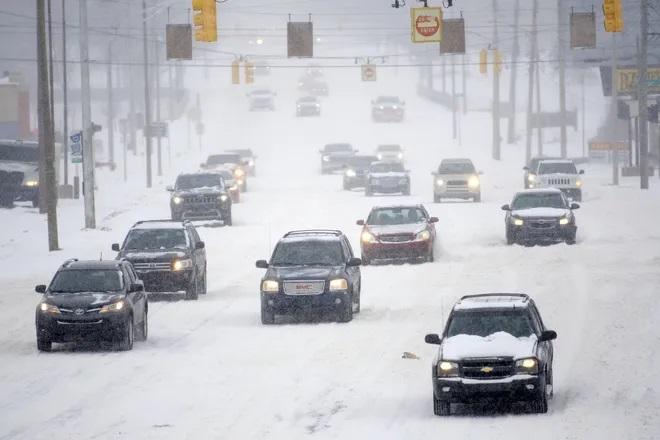Weather is an omnipresent factor influencing road safety, often becoming a critical element in driving conditions. Illinois, with its diverse climate, experiences a range of weather patterns throughout the year, significantly affecting roadways and contributing to car accidents.
Understanding the correlation between weather conditions and car accidents is pivotal in enhancing driver awareness and safety measures across the state.
Seasonal Variations in Illinois
Illinois witnesses distinct seasonal changes, each posing unique challenges for drivers.
Winter Hazards
Every year in the United States, approximately 1.2 million car accidents are influenced by weather conditions. Among these, 29 percent occur on icy, snowy, or slushy roads, while 18 percent happen while snow or sleet is falling.
Illinois stands out as one of the most perilous states for winter driving, averaging 27 fatal accidents during the winter season annually. The cold weather in Illinois introduces frigid temperatures, snowfall, and icy roads, significantly impacting road safety.
Slippery surfaces and decreased visibility contribute to a surge in accidents. Icy patches on highways and city streets often lead to skidding and a loss of vehicle control, frequently culminating in collisions.
Understanding the importance of using snow tires, driving cautiously at appropriate speeds, and maintaining vehicles properly becomes crucial during this challenging period.
Spring Showers and Challenges
In the spring season, particularly noticeable in the southern regions of Illinois such as Edwardsville, abrupt rain showers and thunderstorms are prevalent. TorHoerman Law notes that these weather occurrences create specific challenges for drivers navigating the roads. Wet surfaces reduce tire traction, significantly elevating the risk of hydroplaning.
Moreover, heavy rainfall coupled with decreased visibility substantially increases the likelihood of accidents, emphasizing the crucial necessity for drivers to promptly adjust their driving behavior.
If faced with such an incident, obtaining fair compensation from insurance providers can be challenging. Therefore, seeking the assistance of an Edwardsville personal injury lawyer becomes imperative to navigate through these circumstances and secure rightful compensation.
Furthermore, in rare instances, dust storms can also occur. For example, as reported by The New York Times on May 1, 2023, a dust storm resulted in a tragic incident in rural Illinois. Seven individuals lost their lives, and at least 37 others sustained injuries in a series of crashes along a two-mile section of Interstate 55.
The unusual dust storm, emanating from nearby farms, caused ‘zero visibility’ conditions. This led to a chain of accidents involving 72 vehicles, including passenger cars and commercial vehicles. These collisions occurred on both sides of the highway near Farmersville, Illinois, south of Springfield and west of Indianapolis.
Summer Heat and Roadway Risks
During the summer season in Illinois, marked by soaring temperatures, road conditions can be notably impacted. Statistics consistently reveal a concerning trend: a higher incidence of car accidents occurring during this period compared to others throughout the year. Reports indicate a staggering 270 summertime fatalities in Illinois since 2018, emphasizing the severity of the situation.
Excessive heat can result in pavement buckling, altering road surfaces, and posing potential hazards for drivers, contributing to accidents. Moreover, heightened traffic volume during the summer months due to vacationers and increased travel significantly escalates the likelihood of accidents. This situation creates an environment demanding extra vigilance from drivers to ensure road safety.
Fall Weather and Associated Dangers
During autumn in Illinois, the landscape undergoes a transformation with changing foliage, accompanied by challenging weather conditions like fog and early frost. Foggy conditions causing reduced visibility significantly hinder a driver’s ability to react promptly, elevating accident risks.
Moreover, fallen leaves scattered on roads create additional hazards. These leaves not only obscure lane markings but also become slippery when wet, posing a risk for drivers navigating through them.
The combination of reduced visibility and slippery road conditions caused by fallen leaves emphasizes the necessity for heightened caution while driving. This adaptability in driving behaviors is crucial to mitigate potential risks and ensure road safety during this seasonal transition.
Preventive Measures and Safety Tips
Given the impact of weather conditions on road safety, implementing preventive measures is crucial to reduce car accidents in Illinois.
- Regular Vehicle Maintenance: Ensuring that vehicles are properly maintained, including tire checks, brake inspections, and functional wipers, is vital.
- Safe Driving Practices: Adapting driving behavior to weather conditions by reducing speed, increasing following distances, and using headlights during low visibility is essential.
- Awareness and Preparedness: Staying informed about weather forecasts before commencing a journey and being prepared for changing conditions are key aspects of safe driving.
Conclusion
Weather conditions in Illinois wield a substantial influence on road safety and contribute significantly to car accidents throughout the year. By recognizing these challenges and adopting proactive safety measures, drivers can mitigate risks and contribute to safer roadways for everyone. Staying vigilant, adapting driving habits, and being prepared for varying weather scenarios are crucial steps toward safer travels across Illinois.















